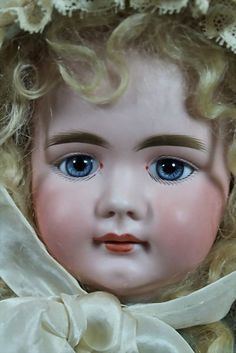 | ||
Simon & Halbig was a doll manufacturer known for bisque doll heads with subtle colouring. They were based in Thuringen, the centre of the German doll industry. They supplied doll heads to many other well known doll makers. These are now collectables.
Contents
Description
Bisque is unglazed porcelain with a matte finish, giving it a realistic skin-like texture. It is usually tinted or painted a realistic skin color. The bisque head is attached to a body made of cloth or leather, or a jointed body made of wood, papier-mâché or composition, a mix of pulp, sawdust, glue and similar materials. Many, like Simon & Halbig, came from the Thuringia region, which has natural deposits of the clay used to make the dolls.
Simon & Halbig was known for excellent sculpting of their doll heads, and the high quality of their bisque (porcelain).
German childlike dolls were predominantly produced between 1890 and 1930.
Examples of these dolls can be found in the Barry Elder collection in the Judges' Lodgings Museum, Lancaster
History
Simon & Halbig was founded in 1839 and began making dolls from 1869 in their two porcelain factories in Gräfenhain and Hidburghausen in Thuringen, Germany.
In 1902 they started a co-operation with Kämmer of Kämmer & Reinhardt in which Kämmer modelled heads and the firm produced them. The heads of the dolls completed by Kämmer & Reinhardt, attached to bodies and legs of more durable composition, were stamped with the marks of both firms. In 1920, Simon & Halbig was bought by Kämmer & Reinhardt, who continued to produce dolls until 1932. The factory became known as Keramisches Werk Gräfenhain.
